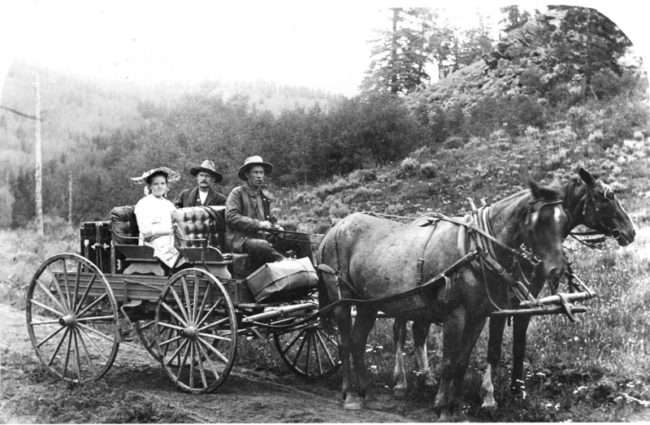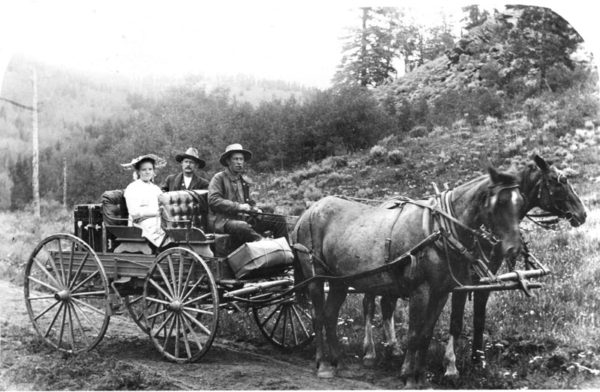By Duane Vandenbusche
The little ranching community on Tomichi Creek preceded the great mining boom in the Gunnison country. Doyleville, located near the mouth of both Hot Springs and Razor Creeks, began in 1876 when 52-year-old Henry Doyle of northern Michigan, his wife and two youngest sons, crossed Marshall Pass and entered the Tomichi Valley. He settled next to the S.W. Davidson family, who had a dairy farm, as did Doyle.
Taking advantage of the 1862 Homestead Act signed into law by President Abraham Lincoln, Doyle acquired 160 acres for $1.25 an acre. He lived in a tent that first summer.
When the Gunnison country mining boom began in 1879, Doyleville became a stop for Barlow and Sanderson stages and for the many freighters en route to Gunnison and nearby silver camps.
Jesse and Frank James came to Doyleville in the 1870s and worked on the Coats ranch, where they hid from the law. Mrs. Coats was a relative of the James boys. Ike Thompson had known Jesse and Frank in Missouri. Jesse drew him aside. “Hello Ike, my name is Brown here. You understand?”

Courtesy of the author.
“I understand alright,” said Thompson and kept his lips sealed. After a three-week stay, the James boys returned to Missouri.
Early Doyleville ranchers underwent hardships from bad roads, no bridges and heavy snow to high water. The arrival of the narrow gauge Denver and Rio Grande Railroad, in July of 1881, enabled hay and cattle to be shipped out and supplies brought in.
Doyleville, at an elevation of 8,064 feet, was 19 miles east of Gunnison, 13 miles west of Sargents and on or near three streams, which provided plenty of water for irrigating lush hay meadows. The little community was also on the Doyleville Cutoff, a 17-mile road that tied in to the much traveled Cochetopa Pass to the south.
For more than 20 years, the Munson and Mitchell Stage Line carried D&RG passengers to the Waunita Hot Springs resort nine miles north of Doyleville.
Before the arrival of the Rio Grande, ranchers profited by selling hay that fed teams of freighters and prospectors heading for mining camps. After the railroad arrived, ranchers shipped hay across the Continental Divide where it sold for $100-$125 a ton. In 1884, 400 cars of hay, sheep and cattle were shipped out.
[InContentAdTwo]
By 1900, Doyleville was a thriving community of 120 people. The little ranch town had a bunkhouse, community hall, depot, a large hotel that burned down in 1910, post office, a 200-yard-long railroad siding and two stores. The school, on the north side of Tomichi Creek, was a one-room frame building heated by a wood-burning pot-bellied stove. A cowbell was used to call the 25 students to their studies. All drank from a bucket of water using a common dipper. Students rode horses to school, which had a term from April to November. The post office at its peak served 200 ranchers along Razor, Hot Springs and Tomichi Creeks.
Doyleville’s ranchers also raised oats, potatoes, rye, wheat, and all had gardens that produced a variety of vegetables. Razor Creek rancher Matt Arch bought a six-horse threshing machine, in 1887, to harvest his more than 500 acres of grain.
The American Timber Company cut timber for railroad ties and telephone poles in the Waunita Springs and Razor Creek areas and shipped them out on the 15-car railroad spur at Doyleville. William Snyder grazed 2,500 cattle on his holdings and open range, from Marshall Pass to Gunnison, a distance of 40 miles. Doyleville experienced a major boost in 1903 when a brief gold mining boom occurred at Bowerman, a few miles from Waunita Hot Springs. For a year or two, stage traffic from Doyleville carried hundreds of prospectors to Bowerman.
In 1911, Doyleville ranchers raised 4,000 tons of hay and sent 50 railroad cars of cattle to the Denver stockyards. The Gunnison News-Champion wrote: “Few would recognize in the prosperous valley dotted by fine dwellings, rich hay fields and thousands of cows, the wildness of the early days.”
Henry Doyle died in 1896 at the age of 72 and was buried in the Doyleville Cemetery. He and J.H. Yates, who built the first cabin on Tomichi Creek near Doyleville in 1873, would have been proud to see what they started. In the shadow of towering and beautiful Tomichi Dome, Doyleville could look back at a rich history as a farming, freighting, railroad, ranching and timbering center as well as having been a major jumping-off point into the Gunnison country.
The railroad tracks were torn out in 1955 and the post office closed in 1969. Today, Doyleville is still ranch country, the great days over – but what days they were!
Duane Vandenbusche, a professor of history at Western State Colorado University in Gunnison since 1962, is the author of several books on the Gunnison country and Western Colorado.

